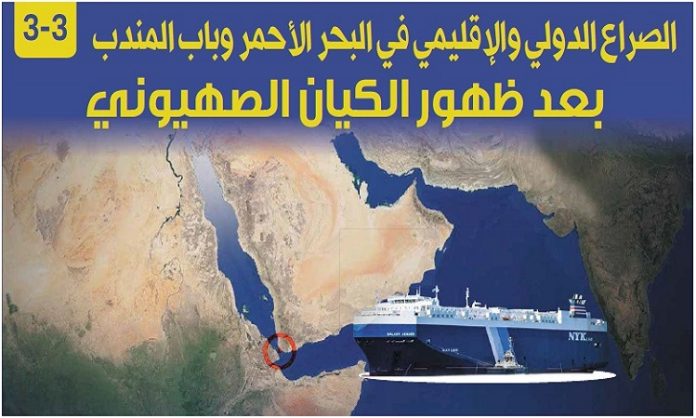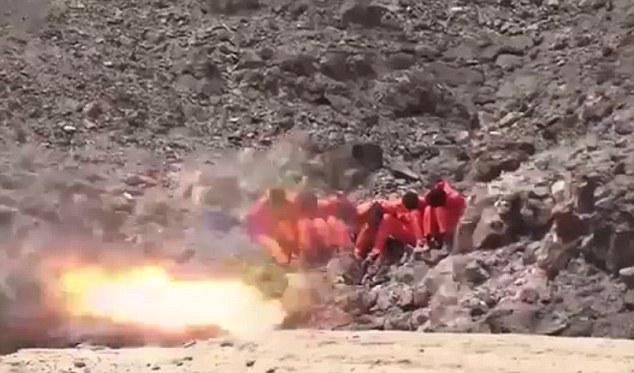The strategic importance of the Red Sea lies in its geographical location that connects three continents: Africa, Asia, and Europe across the Mediterranean Sea, passing through the Egyptian Suez Canal. It is considered an important shipping corridor in the field of political and strategic geography.
This importance overlaps and varies for the riparian countries and regional and international powers, ranging from its security, military, political, economic, social and cultural importance, but the economic importance and the military and security importance remain the greatest drivers of regional and international competition over the Red Sea and its neighboring borders.
This importance made countries and major powers, past and present, trying to dominate the Red Sea and Bab al-Mandab, and seeking in various ways to have a foothold on the shores of the Red Sea in general and on the Bab al-Mandab Strait in particular, and the shores of the countries overlooking it were a reason for their colonization.
The struggle for influence and dominance over the Red Sea takes three overlapping levels: local, regional, and international, and it continues in different forms.
In this paper, we will try to know the international and regional forces influencing the conflict, with a focus on knowing the Israeli role. We are looking for an answer to the question: Will the Red Sea become a purely Western-Israeli zone ? Where do the eastern powers represented by China, Russia, Iran and Turkey stand in this confrontation?
We will also look at the reality of the countries bordering the Red Sea and Bab al-Mandab and the extent to which they are affected by greed and conflict, and we will try to find out why the Somali state has been absent for three decades, and the relationship of the war on Yemen to the Red Sea and Bab al-Mandab?
The Israeli role in the war on Yemen
The Israeli state played an important role in inciting war on Yemen, after the Yemeni “Ansar Allah” movement took control of the capital, Sana’a, on September 21, 2014, and President Abd Rabbuh Mansour Hadi took refuge in Saudi Arabia.
The leaders of the Israeli entity were seized with a state of anxiety similar to that which afflicted them when Britain was preparing to leave southern Yemen and evacuate its bases in Aden and Bab al-Mandab after 128 years of occupation. Therefore, the leaders of the Zionist entity launched a campaign of incitement to war against Yemen and “Ansar Allah” who raise the slogan: Death to America, Death to Israel. (27)
The Israeli role was not limited to incitement only, as its aircraft participated in the war directly, and used tactical neutron bombs in two raids on the mountains surrounding the capital, Sana’a, which they claimed contained sites for storing ballistic missiles.
The Yemeni newspaper “Al-Thawra” published the news, citing the “Veterans Today” website, which analyzed the images of the explosions by two international scientists, one of whom worked at the International Nuclear Energy Agency. (28) Hundreds of civilian casualties occurred in the raids, including dead and wounded.
The entity state also contributed, through its bases on the Eritrean coast off Yemen, by providing logistical and information support to Saudi coalition aircraft flying from bases in Eritrea and Djibouti, as well as to ships besieging the Yemeni coast (29).
Israel reaps the fruits
Prolonging the war in Yemen creates new conditions on the ground that serve the goals of the colonial powers and achieve Israeli interests. The Saudi-led coalition hands over the cities and regions that they claim to liberate, including islands and coasts extending for more than 2,200 kilometers, to multiple militias supported by Saudi Arabia and the UAE, and working with regional agendas, Separatist and sectarian.
Among these components is the so-called “Southern Transitional Council,” which controls three southern governorates, including the city of Aden, which has a strategic location on the Gulf of Aden and close to Bab al-Mandab.
This entity clearly adopts the demands of separating southern Yemen from its north, and the leaders of this entity do not hide their readiness. To join the train of normalization with the Israeli entity state.
In this context, an Israeli newspaper revealed, in a report published in June 2020, the existence of communications between Israeli officials and leaders in the “Southern Transitional Council” in Yemen, and the report included “the wishes and congratulations of the Israelis for the new state within whose borders Bab al-Mandab falls” (30).
Somalia.. a victim of “emperors and pirates” (31)
In 2005 AD, the phenomenon of piracy began in the waters extending from the southern Red Sea to the western Indian Ocean, a thousand miles from the Somali coast. The phenomenon was a reflection of the state of chaos that Somalia has been experiencing since 1991, after the fall of the regime of President Mohamed Siad Barre, and the country entered a state of instability and civil wars fueled by foreign interventions.
For three decades, It was not allowed to restore its state and build its institutions, and when the “Islamic Courts” movement was able to control 80 percent of Somali territory, including the capital, Mogadishu, between the years 2006-2007 AD, piracy operations stopped and not a single incident was recorded, but the United States pushed its allies In the region to overthrow the “courts” government that was accusing Washington of being behind the pirate industry. (32)
After the Ethiopian army intervened and occupied Mogadishu. The “Islamic Courts” government fell and was replaced by a weak authority whose control did not exceed a few neighborhoods in the capital, Mogadishu.
Even the Arab regimes failed Somalia, which is a member of the Arab League, and instead of helping it out of its ordeal, the rivalries between the Gulf Cooperation Council countries constituted an additional factor in destabilizing Somalia, as transferring the Gulf crisis to Somalia contributed to increasing tensions between Mogadishu and the Somali regions and their exit. About the scope of the center. (33)
Instead of striking the pirates bases inside Somalia, the waters south of the Red Sea and the Gulf of Aden, up to the western Indian Ocean, were internationalized and militarized.
The UN Security Council issued three resolutions bearing the numbers: 1814 and 1816 AD in June 2008 AD, then Resolution No. 1851 issued in January 2009 AD. To confront pirates and protect international navigation (34), and these decisions were legitimized by the presence of international powers, led by the United States and its NATO allies, in the waters extending from the southern Red Sea to the western Indian Ocean. The country was placed under Chapter VII.
Somalia was destroyed and became an international model for what is known as a “failed state.” The authority of the internationally recognized failed state has receded over some neighborhoods of the capital, Mogadishu, and it has lost its authority over the land, water, and beaches extending 3,700 kilometers along the Gulf of Aden and the Indian Ocean.
Somalia paid a heavy price for its location at the “head of the Horn of Africa,” overlooking the shipping routes of Bab al-Mandab, the Gulf of Aden, and the Indian Ocean. It was the most prominent victim of “emperors and pirates.” A land without a state, ruled by “Chapter Seven” and permissible waters, and whoever of his children does not find room to live in his homeland, which was destroyed by the ambitions of the Western emperors, and is forced to walk in God’s vast land, will not be spared from humiliation, even if he obtains American citizenship and attains “membership in Congress.” (35)
It seems that there are those who are pushing for Yemen to go the same way. The war led by Saudi Arabia on Yemen since 2015 AD, with American support, falls within the framework of the project of Western-Israeli hegemony over the Red Sea and Bab al-Mandab. It will not only harm Yemen alone, but all of Asia will get its share. Its great countries before its small ones.
This requires the Asian powers affected by the Western project to work to stop the war on Yemen and prevent its dismantling, because remaining unified Yemen guarantees a state of balance of international interests in the Red Sea region, and Bab al-Mandab in particular.
Conclusion
The Red Sea and Bab al-Mandab act like a thermometer to measure the “temperature of the world.” The more tensions between international and regional powers increase, the more this is reflected in the state of the Red Sea, with a fever of ambitions and tensions rising, and interventions and influence efforts to dominate its waters, straits, and shores increasing, and vice versa.
If the Strait of Malacca (36) is described as “the throat of Asia,” then Bab al-Mandab can be described as “the throat of the world” because it geostrategic ally connects the world, east and west.
It seems clear, from what we reviewed previously, that the majority of influence and hegemony in the Red Sea region, Bab al-Mandab, and the Horn of Africa belongs to the Western powers, led by the United States, as these powers, and with them the state of the Israeli entity, work as a unified front in the project of hegemony, through a clear strategy based on centuries. From the colonial legacy.
While the international powers of the East – :China and Russia, and regional: Iran and Turkey – work to protect their interests in the same scope individually, and the positions of the Asian powers seem to acknowledge the legitimacy of Western influence in this vital and sensitive region of the world.
The reasons for the continued competition and struggle over influence in the Red Sea and Bab al-Mandab can be summarized as follows:
1 – The emergence of the Israeli entity state on the land of Palestine, and its quest to dominate the Red Sea and its corridors within the framework of its war against the Arab countries and its quest to establish “Greater Israel”.
The emergence of this entity was not natural, but rather an accident in the region through the force of occupation and oppression, a permanent settlement occupation, different from the nature of the occupations that the region has witnessed, this entity constantly seeks to secure its presence in its surroundings by using force, oppression, and fraud, and is always working to secure its geographical scope by expanding east and west.
In addition, the Zionist entity is working to provoke chaos and conflicts among the peoples of the region, and to redraw its maps on ethnic, sectarian and sectarian grounds, in a way that is consistent with its dreams and projects, by promoting political and economic concepts and projects similar to the “Greater Middle East” and partnership in building “peace.” “Economic” and other similar projects.
2- The disappearance of the Soviet presence and influence in the Red Sea region and the Horn of Africa after the dissolution of the Soviet Union in the early nineties of the last century, a presence that had achieved a degree of international balance in that sensitive region of the world.
3 – The American policy to curb the Chinese rise, which portends the demise of the unipolar era, and to hinder the Chinese ambitions represented in the “Belt and Road” project, as through this project, China can draw a new economic and commercial map for the world.
4 – The existing tension between Tehran and Riyadh, which the Israeli entity is working to fuel and prolong. Likewise, the deep differences that arose between Turkey and Saudi Arabia after the killing of journalist Jamal Khashoggi in the Saudi consulate in Istanbul in October 2018, and Riyadh uses the Red Sea as an arena to settle rivalries.
Repercussions and risks
There are no limits to ambitions and no horizon for ending the fever of competition and struggle over influence in the Red Sea and Bab al-Mandab.
The continuation of this situation will have negative repercussions at the local , national, regional and international levels, which may actually materialize as follows:
1 – Most of the countries of the Red Sea and the Horn of Africa have fragile systems and are vulnerable to disintegration and rupture, similar to what happened to Somalia, or Sudan at best.
It is clear that the dominant Western powers are working to weaken the authorities in the riparian countries, and do not allow the establishment of national systems that take into account the rights and interests of their people in the country. Red Sea region. Therefore, Somalia was left without effective authority for three decades.
In Yemen, the dominant international powers are not making any efforts to stop the war and reach a political settlement after more than five years of war.
2 – The continued state of instability and political unrest in a number of countries in the Red Sea Basin and the Horn of Africa will exacerbate the poverty rate, push towards waves of displacement and migration, and create a fertile environment for terrorism. This has implications for the security and economy of countries in the region and the world.
3 – The fever of competition between regional countries causes them to spend most of their wealth in the field of armaments. For example, the Saudi military budget ranks third in the world, after the United States and China. The arms race in the region will not stop at conventional weapons, as the pursuit of acquiring weapons of destruction is no longer, for some regimes, a task to be carried out in secret, but rather a threat that is being brandished prematurely.
The scope of the conflict will not be limited to the countries bordering the Red Sea and Bab al-Mandeb, and may extend to other countries of the seas and straits. It will fuel the conflicts and wars taking place in a number of countries in the region and prolong their duration. What is happening on Libyan lands may be repeated in another region, as no The country is almost devoid of a flammable hotspot.
The biggest loser and the biggest winner
The strategic importance of the Red Sea and Bab al-Mandab was a major reason for the colonization of the riparian countries for centuries. Although decades have passed since the independence of these countries, they are still living in a state of instability, and their people suffer from backwardness, poverty, and unemployment, and they are the biggest losers in these confrontations.
Yes, the colonists left the soil of their homelands, but their ambitions continued to swim in its waters, while the rights of the coastal countries and the dreams of their peoples sank in the depths of the sea.
There is no doubt that the Zionist entity has achieved major political, security and military gains in the Red Sea and Bab al-Mandab. It’s like a fraudulent gambler playing with a group of rich idiots and taking their money by cheating and fraud. This is what happened.
The entity state began with seven kilometers that it stole from the Egyptian “Umm al-Rashrash” in 1949 AD, then its influence extended to Bab al-Mandab.
The game continues and the new idiots are scrambling to continue playing with the fraudster and gambling on what remains of the Arabian coasts and islands, and the examples are clear in Khartoum and Aden (37).
References and sources:
[27]. The aggression against Yemen enters its sixth year with heavy losses, a report that includes statements by the Yemeni Minister of Information, Al-Alam Channel. Returned on June 30, 2020 AD https://www.alalamtv.net/news/4819181/%D8%A7%D9%84%D8%B9%D8%AF%D9%88%D8%A7%D9%86-%D8 %B9%D9%84%D9%89-%D8%A7%D9%84%D9%8A%D9%85%D9%86-%D9%8A%D8%AF%D8%AE%D9%84%D8 %B9%D8%A7%D8%A9
[28]. Yemeni newspaper Al-Thawra, European testimony: The “Faj Attan” explosion was caused by a tactical nuclear bomb. The news is at the link “Reviewed on July 6, 2020 http://althawrah.ye/archives/116134
[29] Saudi Arabia admits…Israel is openly participating in the war on Yemen, a report by Al-Alam Channel, quoted from the British “Liberty Fighters” website, at the link: https://www.alalamtv.net/news/1964989/%D8%A7% D9%84%D8%B3%D8%B9%D9%88%D8%AF%D9%8A%D8%A9-%D8%AA%D8%B9%D8%AA%% Returned on June 30, 2020
[30]. https://www.israeltoday.co.il/read/israels-new-secret-friend-in-yemen/
Returned on June 27, 2020
[31]. A reference to the title of Noam Chomsky’s book “Emperors and Pirates”
[32] The piracy industry is worth $80 million and extends from Mombasa to Dubai, Al-Quds Al-Arabi, April 29, 2009 AD.
[33]. Somalia and the Gulf Crisis, a report by the International Crisis Group, November 6, 2019, available at the link: https://www.crisisgroup.org/ar/africa/horn-africa/somalia/260-somalia-and-gulf-crisis
Reviewed on June 29, 2020.
[34]. . Previous source.
[35]. A reference to Somali Ilhan Omar, who won a seat in the US House of Representatives from the Democratic Party, and is constantly subjected to racist criticism and harsh ridicule from US President Donald Trump.
[36]. A strait located between Malaysia and the Indonesian island of Sumatra.
[37]. Writer . A reference to the public and secret meetings between Sudanese and Yemeni leaders and Israeli officials






















